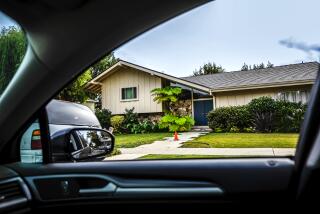Follow Frolics of Tom Sawyer in Mark Twain’s Hometown
- Share via
HANNIBAL, Mo. — Except for the signs and markers, one would hardly guess that this laid-back community provided the inspiration and story material for one of our country’s most celebrated authors and humorists.
Snug, smug and self-possessed, the town of Hannibal meanders along the banks of the Mississippi, 119 miles northwest of St. Louis and proudly lays claim to nurturing the boyhood of Samuel Langhorne Clemens, the indomitable Mark Twain.
Though looked upon as a native son by the locals, Twain was actually born on Nov. 30, 1835 in Florida, Mo., 35 miles to the southwest. It wasn’t until Twain was four years old that the Clemens family pulled up roots and moved to Hannibal. It was here, however, that he spent his youth and later regaled a global audience remembering his hometown in his writings about the escapades of Tom Sawyer, Huckleberry Finn and Becky Thatcher.
His father, Judge John Clemens, built a small, white clapboard house at 208 Hill in 1844 and though structurally changed, it is the same dwelling in which Twain spent his “Tom Sawyer” years. Even the fence that figured in the well-known white-washing episode still stands.
Since many of the family’s possessions were sold at auction to pay off debts, few of the original furnishings remained in the house. The decor was Victorian: itchy horsehair seated chairs, a fine drop-table, a rocker with crocheted headrest and the open family bible. Twain’s lap-writing desk and wooden knife-and-fork tray were on the dining room table.
It was from this room that Peter the cat, breathing fire, jumped out the window after Tom Sawyer gave him a potent dose of medicine.
Upstairs in the small, crowded boys’ room, visitors saw a trundle bed and the window exit frequently used by a young Sam Clemens who shimmied down the drainpipe to reach the ground below. His parent’s room, which became Aunt Polly’s in “The Adventures of Tom Sawyer,” was furnished with a handsome burled walnut bureau and spool crib.
This year, the house is undergoing a major restoration and is presently covered with a huge plastic bubble while workmen reconstruct the house to exactly the way it was when the Clemens family lived there. The furniture is in storage and visitors will see only the shell of the house until it is rededicated in March, 1991. All the other buildings in town are open.
Hopefully, the sterile way that visitors were able to view the house, peering through glass windows at the rooms, will also be improved.
The adjoining Museum, concluded as a Works Progress Administration project in 1937, is patterned after a 100-year-old building that stood on the site. Twain’s gold watch and white jacket, his typewriter and fountain pen, the cap and gown he wore when he received an honorary degree at Oxford, and the small, table-like desk where he wrote “Tom Sawyer” are included in the extensive exhibits and memorabilia. Here, too, are copies of his books in 25 different languages as well as 16 Norman Rockwell paintings that were used as illustrations for special editions of “Tom Sawyer” and “Huckleberry Finn”.
On a busy summer day, the guest registry may show visitors from up to 45 different states and foreign guests represent as many as 15 countries as far away as Nepal and Nigeria, Singapore and Somalia. Presidents that have visited Hannibal include Benjamin Harrison, Theodore Roosevelt, William Howard Taft, Herbert Hoover, Franklin Delano Roosevelt, Harry Truman and Jimmy Carter.
Across the street is the Pilaster House, one of the oldest structures in Hannibal, where the Clemens family lived temporarily with Dr. Orville Grant after they lost their home due to financial setbacks. The first floor has been restored as a drugstore, with old-timey displays of medicine, bottles of herbs and chemicals and pharmaceutical products. For a time, Dr. Grant, who employed Mrs. Clemens as his nurse, ran the drugstore, customary in those days, for physicians who compounded and sold medicine.
Living quarters above are furnished in a fairly elegant fashion, indicating the doctor’s position in Hannibal society. After Judge Clemens died here in 1847, the family moved back to their old house.
At 211 Hill, Laura Hawkins, classmate and childhood sweetheart of Twain in the 1840s was later immortalized in print as Becky Thatcher. The lower floor is divided into souvenir shop and bookstore, stocking the largest selection of books by and about Twain. Upstairs was her bedroom and parlor, all open to the public.
Located at the base of Cardiff Hill, a setting for much of the activity in Tom Sawyer and a favorite haunt of Mark Twain’s is the Tom and Huck Statue, believed to be the first in the U.S. to honor fictional characters. The lighthouse atop Cardiff Hill commemorates the birth of Mark Twain and was dedicated by Franklin Delano Roosevelt in 1935.
Clemens Law Office, where Judge John Clemens practiced as a Justice of the Peace, provided the backdrop for the trial of Muff Potter in “Tom Sawyer”. It is the only building not on the original site, moved away from the flood plain area to preserve the structure.
At 1000 Bird is the 30-room Rockliffe Mansion, once one of the finest river estates in America. It has been beautifully restored and in 1902, on Mark Twain’s last visit, he addressed an audience of 300 from the stairway of this home which is now on the National Historic Register.
Hannibal’s Main Street is lined with renovated buildings from the mid-19th Century, that house specialty shops featuring woven rugs, rag dolls,, quilts, hand-painted folk art, pewter, primitives and hand-crafted baskets.
Several sightseeing tours of the area are available. The Mark Twain Clopper features a horse-drawn wagon; the Twainland Express, an open air tram, covers 10 m.p.h. Various sites can be also be explored on foot or car.
Just a mile south of Hannibal, open for touring since 1886, is the Mark Twain Cave. In his autobiography, Twain wrote: “I think my mother was never in the cave in her life, but everyone else went there. It was a tangled wilderness of lofty clefts and passages. I got lost in it along with a lady and our last candle burned down to almost nothing before we glimpsed the search party’s light.”
Relying on that memory, Twain dramatized Tom Sawyer and Becky Thatcher’s adventure in that cave, being pursued by Injun Joe and it is one of the most thrilling episodes in the book and subsequent movie.
On Rt. 1, just off I-61, is the Garth Woodside Mansion, an outstanding example of Victorian architecture, plus a 600-bush rose garden. Vacant for 43 years, this elegant river estate is now a popular bed and breakfast inn with special events planned for guests.
A 400-passenger, triple-deck riverboat, Mark Twain, offers hourlong cruises during the day and dinner cruises with live music and dancing. Check the sign at Center Street Landing; the schedule varies in the fall.
In an outdoor theater, “The Reflections of Mark Twain,” a two-hour pageant with a cast of 25 local actors, enacts famous episodes from his writings. The dinner-theater plan is reasonably priced. Mid-May through mid-September at Clemens Landing.
The Molly Brown Dinner Theater and Luncheon Show is a fast-paced musical revue with a Gay ‘90s and Roaring ‘20s theme. On the menu are rib eye steak and old-fashioned apple-candy pie.
Special events during the year add to the region’s charm: National Tom Sawyer Days, July 3-8, with contests, crafts and fence painting; Autumn Historic Folklife Festival, the third weekend in October, and Bluegrass Festivals in February and November head the list.
More to Read
Sign up for The Wild
We’ll help you find the best places to hike, bike and run, as well as the perfect silent spots for meditation and yoga.
You may occasionally receive promotional content from the Los Angeles Times.






